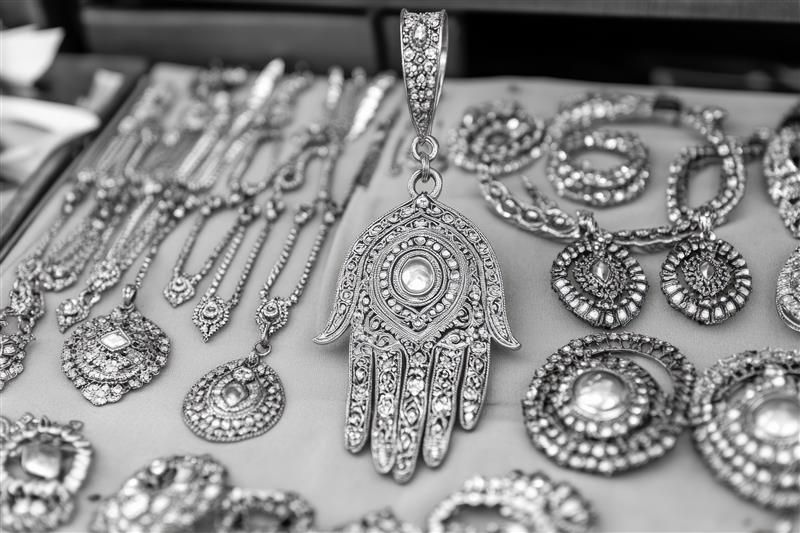
The Definitive Guide to Authenticating Sterling Silver: Protecting Your Business and Customers
Share
In the competitive world of jewelry retail, trust and transparency are your most valuable assets. Customers rely on you to provide them with genuine, high-quality products. As a buyer, navigating the vast market for sterling silver can be challenging, with a wide range of quality standards and a risk of encountering counterfeit materials. This comprehensive guide will equip you with the knowledge to confidently identify authentic sterling silver, empowering you to make informed sourcing decisions, build customer loyalty, and ultimately, ensure the integrity and success of your business. From understanding the crucial hallmarks to learning physical and practical tests, you'll gain the expertise needed to become a discerning buyer of fine jewelry.
Unveiling the "925" Hallmark: The Cornerstone of Authenticity
The most critical and universally recognized indicator of genuine sterling silver is the "925" hallmark. This small but powerful stamp is your first line of defense against counterfeit products. The number signifies that the jewelry is composed of 92.5% pure silver and 7.5% other metals, typically copper. This specific ratio is what gives sterling silver its strength and durability, preventing it from being too soft for everyday wear. A piece of jewelry without this mark should be treated with extreme caution, as it is a strong indication that the item may not be authentic. In addition to "925," you might also see other marks such as "Sterling," "STER," or "S925." All of these are legitimate indicators of the metal's purity.
For retailers, understanding this hallmark is non-negotiable. When you buy charms for jewelry making, verifying the "925" stamp on each piece is essential. This simple step protects you from purchasing inferior goods and allows you to confidently market your products to customers. The presence of a clear, legible hallmark is a promise of quality from the manufacturer and a sign that they stand by their work. This is particularly important for small, intricate items like 925 sterling silver charms, where a fake stamp might be difficult to spot without a loupe. Always take the time to inspect the hallmark on every piece, as it is the foundation upon which your reputation for quality is built.
Beyond the Stamp: Physical and Visual Tests
While the "925" hallmark is the first thing to look for, a truly discerning buyer employs other physical and visual tests to confirm authenticity. One of the simplest and most effective tests is the magnet test. Sterling silver, like pure silver, is not magnetic. If a piece of jewelry is strongly attracted to a magnet, it is likely not genuine sterling silver but a base metal with a plating. Be aware, however, that some clasps and findings may contain steel for strength, so a slight attraction in a specific area might not be a red flag.
Another test involves the metal's smell. Pure silver has no odor, but if you rub a piece between your fingers and it emits a slightly sulfuric or metallic smell, it could indicate the presence of a higher copper content or other alloys that are not part of the standard sterling mix.
Additionally, a close examination of the jewelry can reveal a lot. Fake silver is often plated, and over time, this plating can flake or wear off, revealing a different colored metal underneath. Look for signs of wear, especially on high-friction areas like the edges of a pendant or the clasp of a bracelet. Genuine sterling silver will show consistent color throughout, even with wear. The weight of the item can also be a clue. Because silver is a denser metal, a genuine piece will often feel heavier than a similar-sized piece made of a lightweight, fake alloy. While none of these tests are definitive on their own, using them in combination with the hallmark inspection provides a comprehensive approach to verifying authenticity, allowing you to confidently source wholesale silver charms for jewelry making and other components.
The Crucial Role of Reputable Wholesale Partners
The most effective way to ensure the authenticity of your jewelry supply is to partner with a reputable and transparent wholesaler. A trustworthy supplier of wholesale sterling charms will not only provide pieces with the correct hallmarks but also be able to provide documentation or certificates of authenticity for their materials. They are invested in their reputation and will have rigorous quality control processes in place to ensure that every product meets the promised standard. This partnership goes beyond a simple transaction; it's a strategic alliance that protects your business from the risks of counterfeit products. A reliable wholesaler can also offer you insights into the market, provide support, and assist you in curating a collection that resonates with your customers.
Consider a wholesaler who offers a seamless online platform and clear communication channels. This allows you to ask questions about their sourcing, their manufacturing process, and their commitment to quality. A good partner will be happy to share this information and will likely have a track record of positive reviews from other retailers. When you buy silver charms in bulk, working with a trusted partner minimizes the risk of receiving a large quantity of fraudulent goods, which could be financially devastating to your business. Their expertise and integrity become an extension of your own brand’s promise to its customers, allowing you to focus on selling and marketing without the constant worry of product authenticity.
The Art of Tarnish and Patina
Contrary to popular belief, a piece of silver that tarnishes is often a sign of authenticity. Tarnish is a natural chemical reaction that occurs when sterling silver reacts with sulfur in the air and moisture. This process creates a thin, dark layer on the surface of the metal. While some might see this as a flaw, it is actually a hallmark of genuine sterling silver. Fake or plated jewelry will not tarnish in the same way; instead, the plating will likely chip or wear away over time, revealing the base metal underneath. A sterling silver charm bracelet, over time, will naturally develop a unique patina—a subtle darkening in the recessed areas of the design—that enhances its character and showcases its age and history.
For a retailer, this knowledge is a powerful tool. When a customer asks about tarnish, you can educate them on this natural process, transforming a potential concern into a point of pride. You can explain that tarnish is a sign that their jewelry is made of real sterling silver and not a plated imitation. You can also offer tips on how to prevent or clean tarnish using simple, safe methods like a polishing cloth. This not only demonstrates your expertise but also helps build a stronger relationship with your customers. Embrace the tarnish; it’s not a sign of poor quality but rather a testament to the genuine nature of the material and the story of the piece.
Beyond the Purity: The Importance of Craftsmanship
While purity is paramount, the craftsmanship of a piece of jewelry also provides a wealth of clues about its authenticity and value. A high-quality piece of jewelry is meticulously made, with smooth, polished surfaces and crisp, clean lines. Look at the details: are the settings for stones secure? Is the bail or clasp sturdy? Is the finish uniform and free of scratches or dents? Poorly made jewelry often has visible seams, rough edges, or an uneven finish. These signs suggest a lack of care in the manufacturing process and may indicate a lower-quality material. When you wholesale 925 silver charms, you will notice that reputable suppliers prioritize skilled artisans and rigorous quality control.
The manufacturing process itself is a testament to the final product's quality. Authentic sterling silver jewelry is often crafted using traditional techniques like lost-wax casting, which allows for incredibly detailed and intricate designs. The finishing process—including filing, sanding, and polishing—is often done by hand, and a true artist's touch is visible in the final result. Be wary of jewelry that looks mass-produced and lacks a polished, refined appearance. The craftsmanship of a piece is a reflection of the manufacturer's commitment to quality. By choosing pieces that are well-made and expertly finished, you are not just ensuring the authenticity of the material; you are also providing your customers with a piece of art that will be cherished for years to come.
The Pitfalls of Cheap Sourcing: A Cautionary Tale
In the quest for higher profit margins, some retailers might be tempted to source their products from unverified, low-cost suppliers. This is a dangerous gamble that can have severe consequences for your business and reputation. Cheap jewelry often comes with hidden costs. The materials may not be authentic sterling silver, but a cheaper, plated alloy that will quickly tarnish, flake, or even cause allergic reactions. These problems lead to customer complaints, negative reviews, and a loss of trust that can be difficult to rebuild. A customer who has a bad experience with a product they thought was genuine sterling silver will not only stop shopping with you but may also tell others about their experience, causing significant damage to your brand’s reputation.
Furthermore, these suppliers may have unethical manufacturing practices, use child labor, or pollute the environment. By sourcing from them, you are indirectly supporting these practices, which can be a serious ethical and public relations issue for your brand. While the upfront cost of sourcing high-quality, authentic wholesale sterling charms may be higher, the long-term benefits far outweigh the risks. A high-quality, authentic product leads to satisfied customers, positive reviews, and repeat business. It allows you to build a brand that stands for integrity and quality, which is far more valuable than a few extra dollars in profit per item.
Your Buyer's Checklist for Authenticity
To make the process of sourcing sterling silver jewelry simpler and more effective, here is a quick checklist to guide your decisions. First, always look for the "925" hallmark, or its variations like "Sterling." This is your primary indicator. Second, conduct a physical examination: check for magnetism, and look for signs of wear that might reveal a base metal underneath. Third, verify the supplier's reputation. Look for a company with a long-standing history, positive reviews from other retailers, and a clear, transparent business model. Ask them about their manufacturing process and quality control standards.
Fourth, consider the price. If the price seems too good to be true, it probably is. Authentic sterling silver has a certain market price based on the cost of the raw materials and the craftsmanship involved. Be suspicious of prices that are significantly below the market average. Fifth, ask about their return policy. A reputable supplier will be confident in their product and offer a fair return policy if the item is not as described. By following this simple checklist, you can significantly reduce your risk of purchasing fake or inferior jewelry. This strategic approach will not only protect your investment but also ensure that you are building a business founded on quality and trust.
Conclusion
In the world of jewelry, authenticity is more than just a buzzword; it is the foundation of a successful and sustainable business. As a buyer, your ability to discern genuine silver charm bulk from plated imitations is crucial for building customer loyalty and a strong brand reputation. By understanding the importance of hallmarks, employing simple physical tests, and, most importantly, partnering with a trusted wholesaler, you can confidently navigate the market. Authenticity is not just about the material; it is a reflection of your commitment to quality, integrity, and your customers' satisfaction. Armed with this knowledge, you are ready to build a jewelry collection that not only sparkles but also tells a genuine story of quality and craftsmanship.
